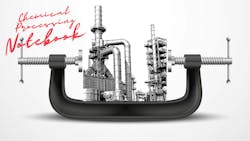Chemical Processing Notebook: Oversupply and Policy Shifts Squeeze Producers
Plant closures and construction delays marked the second quarter for chemical producers, with Dow announcing it would shutter three European plants, Eastman delaying a plastics recycling plant in Texas and Braskem now entering talks to sell U.S. assets.
These developments reflect broader industry pressures as chemical companies navigate tariff uncertainty, weakened demand and an increasingly complex web of trade policies and regulatory shifts. Several chemical manufacturers reported challenges stemming from reduced demand in key sectors like automotive, while simultaneously grappling with massive new capacity additions hitting already oversupplied markets.
Adding to these headwinds is President Trump's "One Big Beautiful Bill Act," which could boost oil and gas development while threatening billions in green-energy investments central to many companies' strategies. The legislation has created acute uncertainty for an industry that spent years building business cases around government incentives for carbon capture, emissions reduction and other sustainability technologies.
To better understand how these converging pressures are reshaping the industry, I spoke with Stephen Ottley, managing director and head of chemicals for Maine Pointe, a global supply chain and operations consulting firm. Ottley highlighted how chemical manufacturers are being forced to fundamentally rethink everything from their manufacturing footprints to their investment priorities amid a volatile global market.
On market oversupply and new capacity challenges
The chemical industry is facing oversupply of many key materials. In 2025, approximately 5 million tons of additional polyethylene capacity is coming on stream in already-oversupplied markets, while 1 million tons of monoethylene glycol capacity is being added to similarly saturated markets. The propylene chain is seeing around 6 million tons of new polypropylene production. These long-term projects are entering markets characterized by soft demand and significant uncertainty. “I’ll give you an example: one of the majors is closing four of nearly 90 plants, and it should probably be closing 20. It’s a perfect storm of oversupply, new capacity and a soft market.” Many of the projects Maine Pointe is working on involve looking at entirely new distribution footprints for chemical manufacturing clients in response to plant closures.
On strategic manufacturing and distribution reorganization
Chemical manufacturers are looking at everything from reshoring or nearshoring to consolidation. Many chemical producers added excess warehousing capacity during the pandemic and are faced with the reality of having to rationalize their storage footprint. The challenge they face is trying to continue servicing customers cost-effectively with fewer distribution points. Companies will need to leverage technologies like digital twins to understand their landed costs and the type of service they can afford to provide their customers. They will need to think through logistics and warehousing scenarios using digital twins that can enable them to remain agile after closing facilities.
On root causes of market oversupply
The current oversupply situation stems primarily from weakened consumer demand across multiple sectors, with automotive being a notable example. Multiple CEOs have indicated this challenging environment is expected to be prolonged, with second-quarter results already reflecting these difficult conditions.
On the potential impact of the “One Big Beautiful Bill Act”
The bill creates a lot of uncertainty involving billions of dollars invested in green-energy projects. “When there are thousands, and I mean thousands of new technologies and startups out there, it's a time when those investors — whether they're private-equity firms, whether they're energy majors — are now thinking, ‘Well, does my investment still make sense?’ We were looking at these startups from a supply chain lens, and many of them had a five- to 10-year path to become commercially viable. This has been a long-term game that's been thrown upside down and put in doubt by the potential withdrawal of these incentives. I think it's a huge time of uncertainty. I think there are a lot of investors — private and commercial energy majors — who are just trying to figure out now, ‘Well, where do we go?’”
About the Author
Jonathan Katz
Executive Editor
Jonathan Katz, executive editor, brings nearly two decades of experience as a B2B journalist to Chemical Processing magazine. He has expertise on a wide range of industrial topics. Jon previously served as the managing editor for IndustryWeek magazine and, most recently, as a freelance writer specializing in content marketing for the manufacturing sector.
His knowledge areas include industrial safety, environmental compliance/sustainability, lean manufacturing/continuous improvement, Industry 4.0/automation and many other topics of interest to the Chemical Processing audience.
When he’s not working, Jon enjoys fishing, hiking and music, including a small but growing vinyl collection.
Jon resides in the Cleveland, Ohio, area.


